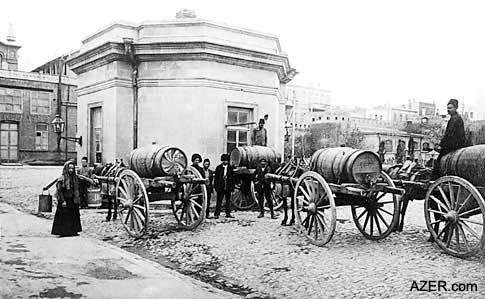|

Summer 2002 (10.2)
Page
54
Building Infrastructure
Taghiyev's
Commitment to the Water Problem
by Manaf Suleymanov

Above: Water distribution in Baku after the
Shollar Water works were installed. Photo after 1917.
Other articles related to Zeynalabdin
Taghiyev, Baku Oil Philanthropist
(1) Legacy
of the Oil Barons by Fuad Akhundov (AI 2:2, Summer 1994)
(2) Just for Kids: The
ABCs of Baku (Monogram of Taghiyev) in (AI 6.4, Winter 1998)
(3) Quote: Education
of Women - Haji Zeynalabdin Taghiyev (AI 6:3, Autumn 1998)
(4) Quote: Written
Word Brings Happiness - Haji Zeynalabdin Taghiyev (AI 8:1,
Spring 2000)
(5) The
Taghiyev Museum (AI 8.2, Summer 2000)
(6) Baku's
Architecture - Identity of Architects and Financiers Revealed
(AI 9:4, Winter 2001)
(7) Baku's Search for Water:
A Brief Chronology by Mammad Mammadov (AI 10.2, Summer 2002)
_____
The people of Baku suffered
greatly because the city lacked a good water supply. In the 1880s,
city management started dealing seriously with this issue. But
oil baron Haji Zeynalabdin Taghiyev was the most active in pursuing
exploration and construction activities to solve this problem.
At first, the officials tried to find a source of water inside
the city of Baku, then in Shamakhi, but without success. In 1892-1893
a new project was proposed - the construction of a water pipeline
from the Kur River [which runs from the northwest to the southeast
through the country]. However, the plan was rejected because
it was thought to be too expensive.
In the end, the city management decided to build a desalination
plant to process water from the Caspian. But the plant could
only handle approximately 30,000 buckets a day - not enough for
the city's population. Moreover, the water had a reddish-brown
color and a bad smell and taste. So the people preferred to use
water from wells, which wasn't good at all. Studies indicated
that out of the 800 wells in the city, only 100 were good enough
to use. In 1892 a cholera epidemic broke out.
In 1898, the city purchased more desalination equipment. In the
meantime, merchants sold water that had been taken from the Kur
and Volga rivers. A bucket of Kur water cost 0.5 kopek, and Volga
water - two kopeks. The poor people who couldn't afford to buy
water had to use the bad water from the wells. As a result, infectious
diseases often broke out. The city administration regularly carried
out disinfectant programs; sometimes it just closed the bad wells.
In 1899 Taghiyev signed an agreement with a foreign company for
25,000 rubles and invited British engineer William Lindley, who
had considerable engineering experience constructing water pipelines
in European cities, to come to Baku to help the city solve its
water problem. This time, Taghiyev informed the city officials,
a pipeline would be constructed. It didn't matter if the money
came from the city treasury or his own wallet.
In the end Lindley found water - Shollar water - near Guba, 190
km north of Baku. According to Lindley's calculations, this source
was enough to provide water for the entire city. However, the
city's management was skeptical and wanted to table Lindley's
project. Taghiyev didn't let it happen. He kept insisting, "Just
as Shahdagh [the highest mountain peak in Azerbaijan] will exist
forever with its snow and ice, so will Shollar water. As for
me, I won't begrudge the money or the effort. I'll do my best
to provide my native city with water, even if I have to spend
my entire fortune."
Not long thereafter, an official from Baku went to Paris and
stayed at the Louvre Hotel. Having learned that Taghiyev was
staying at the same hotel, he went to visit him. With the help
of a translator, Taghiyev was conducting a lively discussion
with a Parisian official - namely, the mayor of Paris.
Taghiyev mentioned that he was going to see the water system
of Paris. "You're welcome to join us if you want,"
he told the Baku official. That day they traveled all over Paris.
Taghiyev worked tirelessly. He kept bombarding the French specialists
with questions: "What's this? What's that device used for?"
The Baku official got very tired, but Taghiyev went on exploring
and inquiring, as if the very goal - the meaning of his life
- were to construct a water pipeline.
In 1903, a private company built a water pipeline from Zaghulba.
The company that supplied water from Kur also expanded its activity.
The Nobel and Zubalov brothers built a modern water desalination
plant. Those who were already supplying Baku with water - individuals
as well as trade societies like Caspian, Caspian-Black Sea and
Arzamas - tried to block Taghiyev's pipeline construction because
they knew it would mean a loss of their own income. But the city
management, under Rayevsky's leadership, sided with Taghiyev.
Construction on the pipeline moved very slowly. To speed up the
process, Taghiyev and Rayevsky sent lawyer Mammad Hassani to
St. Petersburg to ask the state government for a 5 percent loan.
At the end of 1909, Russia's Council of Ministers issued a 27-million-ruble
loan with 5 percent interest. The project was confirmed, and
by 1911, the construction had begun again at a renewed pace.
According to calculations, the pipeline would convey 3 million
buckets a day. Other oil industrialists, following Taghiyev's
example, invested in the project as well. Taghiyev himself used
to visit the construction site nearly every day and present workers
with gifts and money.
Construction of the pipeline was completed in late 1916. Special
booths with domes were built on all of the streets, with a special
guard at each one to control the water distribution. These booths
were called "fountains". Special water coupons were
issued.
The grand opening ceremony for Shollar took place on February
18, 1917. People swarmed into the streets to celebrate this event.
With a Koran in his hands, Mir Mahammad Karim delivered a speech
about the importance of water for the sustenance of human life.
He expressed his gratitude to all who had participated in this
undertaking, especially emphasizing the great contribution that
Taghiyev had made to the project. Taghiyev himself was given
the honor of turning on the water faucet for the first time.
He, in turn, shared this privilege with Aghajava, an elderly
blacksmith who had worked hard to help construct the pipeline.
Below: Manaf Suleymanov
  It's impossible to convey how ecstatic
everybody was that day. Sheep were sacrificed; so were oxen and
camels. Feasts were organized, and food and clothing were distributed
to the poor. It's impossible to convey how ecstatic
everybody was that day. Sheep were sacrificed; so were oxen and
camels. Feasts were organized, and food and clothing were distributed
to the poor.
The water was made available three times a day - morning, afternoon
and evening.
On this occasion, Taghiyev and the city management received so
many congratulatory telegrams. Rayevsky, the former head of the
city, wrote from St. Petersburg that Taghiyev's quarter-century-long
efforts had not been in vain, and he congratulated him on this
truly important event for the city of Baku.
From Manaf Suleymanov's book,
"What I Heard, What I Read, What I Saw," published
in 1990 by Azerbaijan Publishing House and translated here by
AI staff member Arzu Aghayeva.
____
Back to Index
AI 10.2 (Summer 2002)
AI Home
| Magazine
Choice
| Topics
| AI Store | Contact us
Other Web sites
created by Azerbaijan International
AZgallery.org | AZERI.org | HAJIBEYOV.com
|


